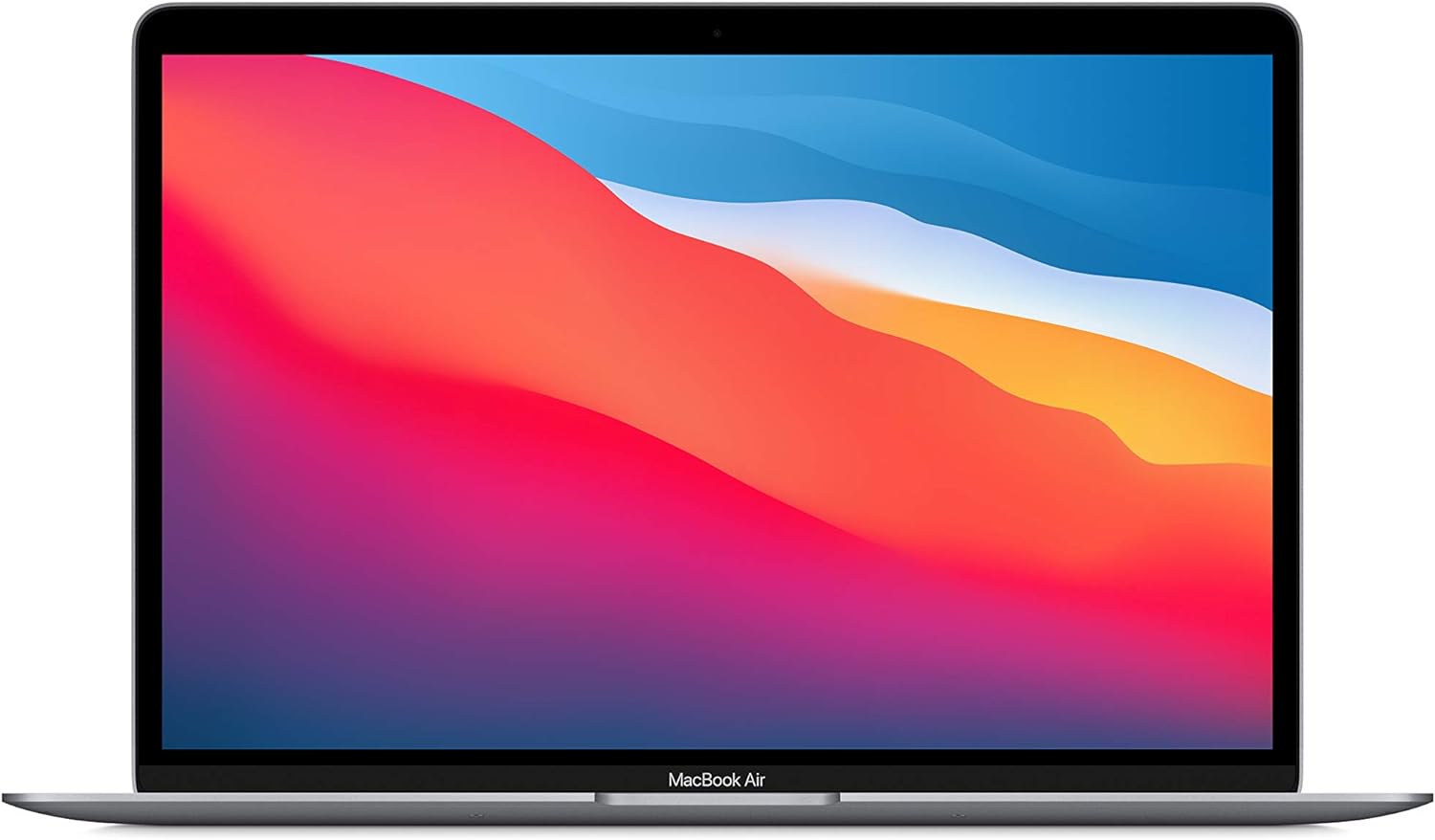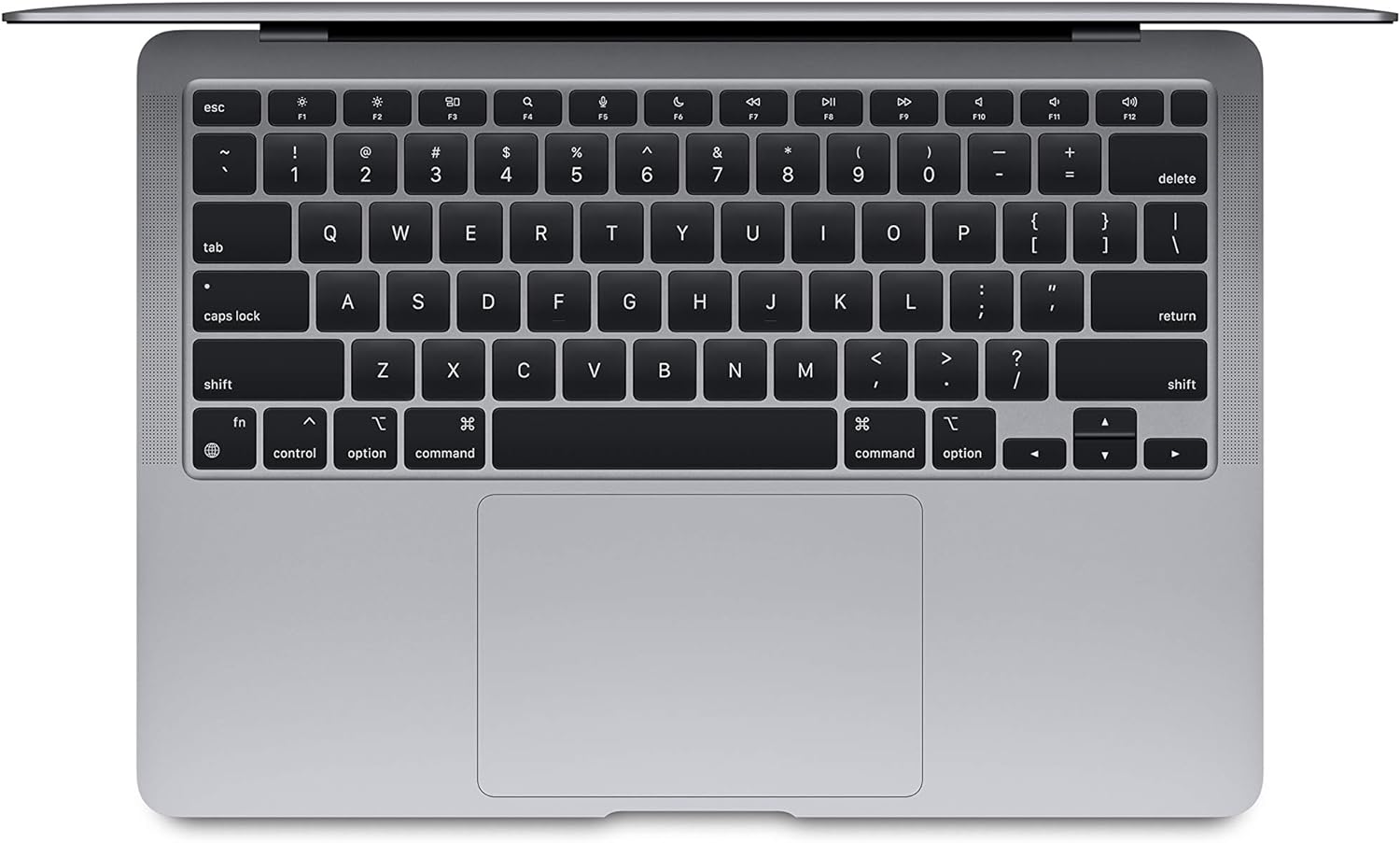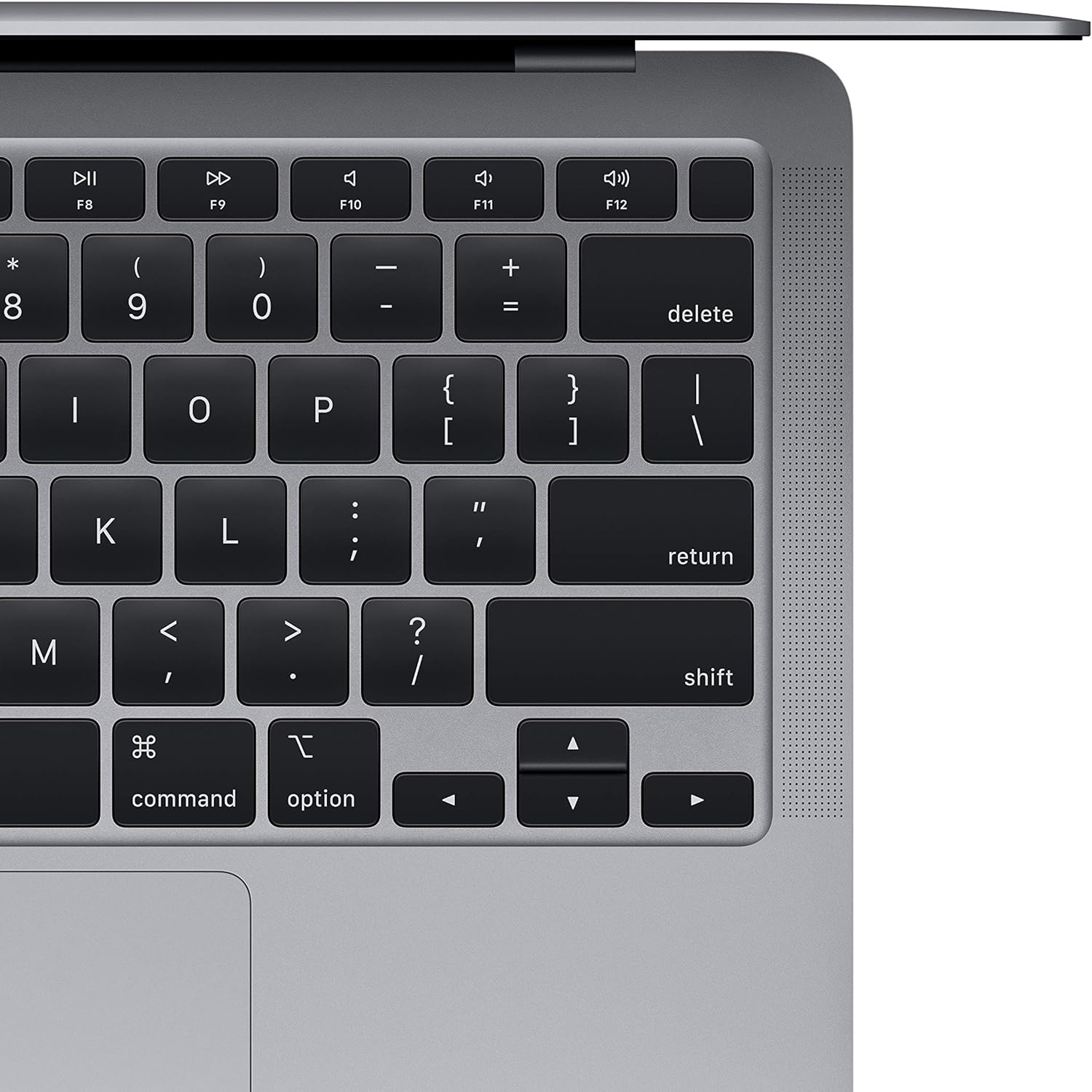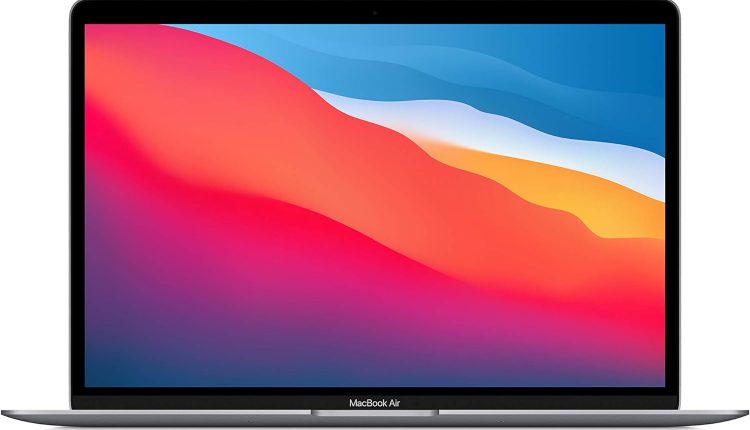Apple 2020 MacBook Air takes portable computing to new heights with all-day battery life, blazing fast performance, and an incredibly lightweight and sleek design. The Apple MacBook Air 2020 has been the subject of much anticipation, promising unparalleled performance with the groundbreaking M1 chip. In this review, we delve into every aspect, from design to user experience.
Pros
- Astounding 18-hour battery life so you can work or play from dawn to dusk
- Lightning fast M1 chip delivers up to 3.5x faster CPU performance
- Vivid 13.3″ Retina display makes photos, videos, and games burst with realism
- 8GB RAM handles demanding multitasking like a pro
- Two versatile Thunderbolt ports for superfast data transfers and charging
- Runs cool and quiet thanks to innovative fanless design
- Seamlessly works with all your Apple devices
Cons
- Relatively expensive compared to Windows laptop alternatives
- Limited to two Thunderbolt ports
- Not ideal for graphics-intensive applications like 3D modeling or video editing
For professionals, students, and creators seeking the perfect blend of performance, portability, and endurance, the 2020 MacBook Air soars above the competition. Keep reading this review for an in-depth look at why it deserves a spot in your bag.
Unstoppable All-Day Endurance

The bane of every road warrior? The dreaded low-battery warning popping up right before an important video call. With the 2020 MacBook Air, you can finally bid farewell to squirreling around for spare charging cables.
The brilliant engineers at Apple have crammed an extraordinary amount of battery capacity into the svelte MacBook Air chassis. You get up to a whopping 18 hours of uptime from a single full charge.
It doesn’t matter if you’re crisscrossing time zones for 12 hours, video conferencing with colleagues, or hunkering down at the neighborhood café to edit images. The MacBook Air has your back from the early morning commute to the late-night coding session.
Lightning Fast Performance – The Apple M1 Chip Rules
The key ingredient giving the new MacBook Air its wings is Apple’s groundbreaking M1 system-on-chip. This 8-core marvel delivers transformational speed and efficiency gains compared to previous Intel-powered MacBook Airs.
CPU performance leaps by a massive 3.5x versus older models. Everything from compiling code to crunching Excel spreadsheets happens lickety-split. Moreover, the M1 has dedicated machine learning and AI acceleration cores to handily chew through intensive workloads like image upscaling, voice recognition, and natural language processing.
The M1 also significantly steps up graphics muscle. Games, 3D visualizations, ML model training – the MacBook Air breezes through tasks that would choke comparable ultraportables.
Clearly Apple has knocked it out of the park with its custom silicon that melds desktop-caliber grunt with super slim form factors and tablet-esque battery runtimes. The M1 forcefully heralds a new computing paradigm.
Vibrant Retina Display Brings Photos and Videos to Life
Binge-watching movies, fine-tuning images for your social feeds, showing off vacation pics to gathered family – such visual activities pop with the MacBook Air’s sublime 13.3″ Retina LED display.
With a pixel density of 227 ppi, UI elements look razor sharp while maintaining natural smoothness free of pixelation artifacts. Photos exhibit remarkable fidelity and films come alive with cinematic qualities. Wide viewing angles further cement the display’s credentials for sharing content.
The generous 2560 x 1600 resolution neatly accommodates multiple windows side-by-side, critical for today’s multitasking needs. Compared to full HD displays, the higher pixel count reduces eyestrain over long computing marathons.
For creators requiring color accuracy like photographers and graphic artists, the display nails critical standards like 100% sRGB coverage and supports 1 billion hues.
In a nutshell, whether you’re editing 4K drone footage or marking up documents, the MacBook Air’s screen serves up an exemplary visual experience.
Hyperfast Memory to Support Extreme Multitasking

Rapidly switching between browsers crammed with dozens of pinned tabs, having multiple IDEs, editors, churning through multi-gigabyte datasets – the 8GB of high speed LPDDR4X memory proves integral to the MacBook Air’s seamless multitasking capabilities.
8 gigs used to be considered ample RAM not long ago but improving silicon now lets Apple condense system memory without sacrificing performance. Workloads gracefully spill over to blazing-fast SSD storage instead of lagging if RAM bottlenecks. The M1’s unified system architecture further minimizes latency when juggling tasks.
So while benchmarks heavily factor memory capacity in determining system speed, real-world responsiveness ultimately depends on synergy between the SoC, RAM and storage. On that front Apple’s tight hardware/software integration hits a home run.
Even if your workflow entails running an Android emulator, 15 browser windows, Illustrator, Photoshop, Lightroom, Spotify, Slack and large Excel pivot tables simultaneously, the MacBook Air takes it all in stride without breaking a sweat. Try doing that on any competing slim-and-light notebook!
Bi-Directional Thunderbolt Ports – Breaking the Connectivity Bottleneck
A chronic pain point with ultralight notebooks has been woefully inadequate ports hampering productivity on the go. Pleasingly the MacBook Air specifications include not just one but two versatile Thunderbolt 3 ports.
These state-of-the-art interfaces deliver lighting fast 40Gbps bandwidth enabling a range of crucial capabilities:
- Support dual 4K displays along with charging at up to 96W
- Hook up high speed external SSDs for storage expansion or backup
- Leverage advanced docking stations to plug in multiple peripherals using a single cable
- Charge mobile phones and other USB-C gadgets
Thunderbolt handily future-proofs connectivity so you can bank on the ports staying relevant for years. While not quite matching the I/O flexibility of chunkier traditional laptops catering to stationary usage, the two Thunderbolt pipes strike the perfect balance for a road-optimized machine.
Fanless Design = Cool, Quiet Operation

Since every ounce matters for an on-the-go device, Apple ingeniously engineered the MacBook Air to run sans cooling fans. This yields multiple practical benefits:
- MacBook Air stays pleasantly quiet even when you’re really pushing the laptop to its limits with heavy number crunching or video exports. No distracting whirring or whooshing sounds.
- The chassis does not heat up excessively despite the thin profile and snugly packed internals. You can have it on your lap for prolonged periods without discomfort.
- Removing mechanical components like fans reduces potential points of failure down the line, improving long term reliability.
- Marginal savings in weight compared to fan-cooled models. Every gram counts when you’re traveling light.
Eliminating fans needs tremendous thermal optimization between the aluminum unibody chassis, internal layout, heat pipes and the highly efficient M1 chip not wasting energy emitting excess heat in the first place. Hats off to Apple engineering for pulling off active cooling within an impossibly slim form factor with no throttling or performance caveats.
Designed to Work Seamlessly with Your Apple Ecosystem
While MacBooks excel as standalone computing devices, they truly shine when used in conjunction with other Apple gear like iPads and iPhones.
The integration goes far beyond basic Bluetooth peripherals support. For instance you can:
- Use an iPad as a secondary MacBook Air display boosting screen real estate
- Seamlessly drag and drop files between devices
- Directly run iPad and iPhone apps natively
- Unlock your Mac and approve Apple Pay payments via Apple Watch
- Answer SMS texts or take calls directly on your MacBook
- Instantly AirDrop vacation photos from iPhone to MacBook
- Control HomeKit devices right from the Mac
- Detect proximity between devices for auto-unlocking functionality
- Shift tasks back and forth between platforms for optimal user experience
So if you’re entrenched within the Apple ecosystem, buying the MacBook Air effectively upgrades your entire setup leading to major productivity and convenience dividends.
Who is the MacBook Air Perfect For?

The MacBook Air hits a winning sweet spot balancing performance, portability, and value. But who will get the most joy and mileage out of this exceptional thin and light notebook?
Mobile Professionals who are primary on email, web browsing, video calls, presentations and office productivity thrive on the all-day battery life coupled with brisk speeds. The Air keeps them connected and productive wherever work takes them thanks to the svelte chassis and wireless connectivity.
Students benefit from robust build quality surviving long term backpacking while sacrificing no processing punch to blaze through research, assignments and essays on the gorgeous Retina display. Avid gamers will also appreciate gaming on the go.
Creators desiring premium Apple build quality alongside ample graphics pep for photo editing, 1080p video cuting, music production and lightweight 3D modeling find fantastic bang for buck given how attractively Apple prices the Air relative to the flagship MacBook Pro line.
Frankly anyone wanting MacOS’s slick user experience while prioritizing mobility over sheer computing muscle will find their ideal road companion in the Air. The machine pulls off the nifty trick of packing enterprise-grade productivity into a backpack friendly shell.
Wrapping Up – Hard to Beat Bundle
The latest revision confidently secures Apple’s leadership position in the ultralight notebook category by setting new benchmarks for performance per watt. Factor in MacOS’s intuitive workflows, Apple’s service ecosystem and baseline product quality, and the MacBook Air makes a compelling case as a daily carry machine for on-the-go lifestyles.
For under $1000 you net rock solid unibody construction, spine-tingling battery runtimes up to 18 hours, desktop class CPU speeds in a fanless chassis, Thunderbolt ports and a gorgeous high resolution display fitting multitasking workloads. Oh and that singular touchpad/keyboard fusion only Apple has quite perfected.
The confluence of breakthrough Apple silicon, thoughtful hardware/software integration and leveraging cloud ecosystems sets up the M1-powered MacBook Air as a formidable road warrior. If you seek more screen acreage or discrete GPU the 14-inch or 16-inch MacBook Pro modelsbeckon. Nonetheless, the 2020 MacBook Air strikes an unbeatable balance given its particular design constraints.
Performance Compared to Windows Ultrabooks
How does the blazing fast Apple M1 silicon fare against rival Windows ultraportables? Quite favorably as evidenced by benchmark results.
The MacBook Air decisively beats out 12th Gen Intel Core i7 U series chips powering premium lightweight notebooks like the Dell XPS 13 and Microsoft Surface Laptop 4. These ship with upgraded LPDDR5 RAM and cutting-edge Thunderbolt 4 ports yet still trail the Apple M1’s brute force computational throughput.
In multi-threaded workloads leveraging all 8 CPU cores, the M1 leaves the Intel competition in the dust with Geekbench 5 scores exceeding 7000. For single thread the 5GHz P-cores in the Core i7 nip ahead slightly but the M1 still impresses given its power efficiency.
Graphics intensive apps and games highlight Apple’s silicon engineering prowess. The 8-core integrated GPU breezes past Intel’s Iris Xe integrated graphics for smooth AAA title playability at High settings unheard of for non-gaming ultraportables.
What explains the M1’s strong lead given how Apple is the silicon new kid on the block? A couple factors – the 5nm transistor density enables more cores at lower TDPs. But more crucially, the unified system memory architecture feeds the GPU and CPU with data 5x faster than discrete solutions. Performance explodes as a result.
So if you seek outsized performance in slender form factors, the MacBook Air simply can’t be matched by equivalent tier Windows machines. You’ll need to step up to far bulkier gaming laptops costing multiple times as much to rival the M1’s productivity chops!
Expandability Limitations
The downside of pursuing no-compromise portability does impact potential expandability down the line. As discussed earlier, the M1 Air packs merely two Thunderbolt channels for plugging peripherals.
Moreover the M1 SoC and memory are surface mounted onto the motherboard ruling out trivial upgrades. The SSD storage can be swapped out with some effort but limited to a maximum 1TB configuration.
This necessitates carefully assessing your long term storage needs before purchase. Springing for 512GB or 1TB configs make sense if you intend stashing Photos libraries, multi-gigabyte video projects or Windows dual boot partitions.
Lack of HDMI or full sized USB-A ports entails packing dongles when presenting on projectors or hooking up older peripherals. Thankfully the omission streamlines packing otherwise required by more generic computing devices.
If upgradability ranks foremost for your usage then exploring the Intel-based Mac mini maybetter suit since it offers memory expansion and more generous I/O options suited for deskbound environments.
Recommended Accessories
To amplify productivity and safeguard your investment, consider these accessory recommendations:
USB-C Hub – Add legacy ports like 4K HDMI, USB-A, SD card reader
External SSD – Boost storage for large media libraries
Wireless Mouse – Reduce repetitive strain and pinch zoom fatigue over trackpad alone
Laptop Sleeve – Protects from scrapes and absorb minor impacts during transit
Optional accessories catering to power users:
Docking Station – Quickly connect multiple desktop peripherals like mechanical keyboards.
External Monitor – Extra screen room for researching while writing papers.
USB-C Multiport Adapter – Compact dongle fitting HDMI, VGA, USB-A ports for on the go connectivity
Closing Thoughts
The late 2020 MacBook Air overhaul constitutes one of the most significant laptop upgrades in recent memory thanks to Apple Silicon transforming efficiency metrics. By combining best-in-class power draw with sustained peak performance in a supremely portable chassis, the machine delivers an unparalleled user experience.
For the majority of buyers wanting the premium Apple notebook experience while remaining unfettered by AC wall proximity, the MacBook Air is hands-down the smartest choice packing more than enough horsepower. Creative pros may pine for a Touch Bar or discrete GPU tossed into the 14-inch MacBook Pro but the Air nails its mainstream focus admirably.
Assuming your workflow involves everyday tasks like email, web browsing, presentations, video calls rather than specialized applications needing ISV certification, the M1 powered MacBook Air guarantees extreme untethered productivity paired with legendary Apple innovation.
| Technical Details | Details |
|---|---|
| Display | 13.3-inch LED-backlit display with IPS technology; 2560-by-1600 native resolution at 227 pixels per inch with support for millions of colors |
| Processor | System on Chip (SoC) Apple M1 chip; 8-core CPU with 4 performance cores and 4 efficiency cores; 16-core Neural Engine |
| Graphics and Video Support | Up to Apple 8-core GPU |
| Charging and Expansion | Two Thunderbolt / USB 4 ports with support for: Charging, DisplayPort, Thunderbolt 3 (up to 40 Gbps), USB 3.1 Gen 2 (up to 10 Gbps) |
| Wireless | 802.11ax Wi-Fi 6 wireless networking; IEEE 802.11a/b/g/n/ac compatible. Bluetooth 5.0 wireless technology |
| In the Box | 13-inch MacBook Air, 30W USB-C Power Adapter, USB-C Charge Cable (2 m) |
| Height | 0.16–0.63 inch (0.41–1.61 cm) |
| Width | 11.97 inches (30.41 cm) |
| Depth | 8.36 inches (21.24 cm) |
| Weight | 2.8 pounds (1.25 kg) |
| Release Date | 11/10/2020 |


